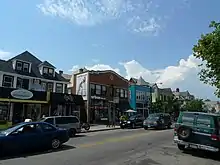
The city of Buffalo, New York consists of five sectors of thirty-five different neighborhoods, over an area of fifty-two square miles.[1][2]
Background
The boundaries of Buffalo's neighborhoods have changed over time. The city is officially divided into five areas with each containing several neighborhoods; in total, there are 35 of them in the city.[3]
Some neighborhoods in Buffalo have seen increased investment since the 1990s, beginning with the Elmwood Village.[4] The redevelopment of the Larkin Terminal Warehouse in 2002 led to the creation of the Larkin District, home to several mixed-use projects and anchored by corporate offices.[5] Downtown Buffalo and the central business district (CBD) saw a 10.6% increase in residents from 2010–2017 as over 1,061 units of housing came online,[6] continuing into 2020 with the redevelopment of the Seneca One Tower.[7] Other revitalized areas include Chandler Street in the Grant-Amherst neighborhood and Hertel Avenue in Parkside.[4][8]
In 2017, the Buffalo Common Council adopted its Green Code, which was the first overhaul of the city's zoning code since 1953. Its emphasis on regulations which promote pedestrian safety and mixed usage of land earned an award at the Congress for New Urbanism conference in 2019.[9]
Central
The Central sector contains Downtown Buffalo as well as portions of the Outer Harbor.[10]
East
Masten Park
Delavan Grider
Also known as "Lamp City"
Ellicott
Fillmore-Leroy
Pratt-Willert Park
Fruit Belt (Medical Park)
Genessee-Moselle
Hamlin Park
The Hamlin Park Historic District was listed on the National Register of Historic Places in 2013.[11]
Kenfield
Kensington-Bailey
Lovejoy
MLK Park
Broadway-Fillmore
Schiller Park
North
Black Rock
Central Park
Grant-Amherst
North Park
Parkside
See Parkside East Historic District and Parkside West Historic District.
Riverside
University Heights
West Hertel
South
South Buffalo, which was split by the construction of Interstate 190 during the 1950s, is troubled by the presence of a concrete crushing facility which is grandfathered in as a pre-existing use, while dust and truck traffic from the facility strongly affect residences in the neighborhood.[12]
First Ward
Hopkins-Tifft
Kaisertown
Seneca Babcock
Seneca-Cazenovia
South Park
West
Allentown
Elmwood-Bidwell
Elmwood-Bryant (Elmwood Village)
The American Planning Association named the Elmwood Village neighborhood in Buffalo one of ten Great Neighborhoods in 2007.[13] Elmwood Village[14] is a pedestrian-oriented, mixed use neighborhood with hundreds of small, locally owned boutiques, shops, restaurants, and cafes. The neighborhood is located to the south of Buffalo State University.
Linwood Historic District
Runs along the entirety of Linwood Avenue from North Street in the south to West Delavan Avenue in the north.
Lower West Side
See West Village Historic District and Fargo Estate Historic District.
Upper West Side
West Side
References
- ↑ Dewey, Caitlin (March 17, 2019). "Fruit Belt fights for its name over fears big tech is erasing it". The Buffalo News. Retrieved 11 May 2021.
- ↑ Buffalo Urban Renewal Agency. "Neighborhood Profile". data.buffalony.gov. Retrieved 11 May 2021.
- ↑ Dewey, Caitlin (March 17, 2019). "Fruit Belt fights for its name over fears big tech is erasing it". The Buffalo News. Archived from the original on January 30, 2021. Retrieved 11 May 2021. and Buffalo Urban Renewal Agency. "Neighborhood Profile". data.buffalony.gov. Archived from the original on May 11, 2021. Retrieved 11 May 2021.
- 1 2 Sommer, Mark (April 10, 2018). "Elmwood grapples with growth, but there's harmony on Hertel". The Buffalo News. Retrieved 23 May 2021.
- ↑ Caya, Chris (March 24, 2014). "Brewery's choice typifies growth of Larkinville". WBFO. Retrieved 23 May 2021. and Schneider, Keith (2013-07-31). "Once Just a Punch Line, Buffalo Fights Back". The New York Times. Retrieved 23 May 2021.
- ↑ "Downtown Buffalo: Looking Ahead With A Clearer View" (PDF). Buffalo Niagara Partnership. 2018. Retrieved 23 May 2021.
- ↑ Epstein, Jonathan D. (January 28, 2021). "After years of inaction, downtown development is a bustling scene". The Buffalo News. Retrieved 23 May 2021.
- ↑ News Editorial Board (November 1, 2019). "Editorial: U-turn on Chandler Street". The Buffalo News. Retrieved 23 May 2021.
- ↑ Teaman, Rachel (July 9, 2019). "Buffalo Green Code, with a national award, builds on 20 years of planning for place-based urban regeneration". ap.buffalo.edu. Archived from the original on August 21, 2019. Retrieved 9 May 2021.
- ↑ Urban Strategies Inc. (May 2015). "Appendix B: Character Area Descriptions". Downtown Buffalo Infrastructure and Public Realm Master Plan (PDF). Retrieved 12 May 2021.
- ↑ "National Register of Historic Places Listings". Weekly List of Actions Taken on Properties: 7/08/13 through 7/12/13. National Park Service. 2013-07-19.
- ↑ "Buffalo’s decade-long dust bowl" article by Dan Telvock in Investigative Post April 3, 2014 Archived April 7, 2014, at the Wayback Machine
- ↑ "American Planning Association". Retrieved October 4, 2007 Archived October 11, 2007, at the Wayback Machine
- ↑ "Forever Elmwood – The Elmwood Village Association". Foreverelmwood.org. Archived from the original on August 10, 2013. Retrieved August 1, 2013.
